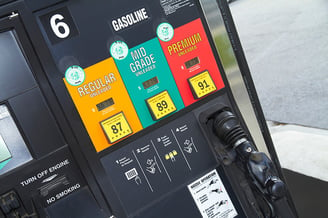8 Tips for Fleet Managers to Save on Fuel Costs

 Fuel costs are generally a fleet’s largest expense, as much as 60% of total operating costs. This amount of expense makes it necessary to take steps to reduce fuel costs. It is not just good for your bottom line, it is also good for the environment, as increased fuel efficiency also helps reduce carbon emissions.
Fuel costs are generally a fleet’s largest expense, as much as 60% of total operating costs. This amount of expense makes it necessary to take steps to reduce fuel costs. It is not just good for your bottom line, it is also good for the environment, as increased fuel efficiency also helps reduce carbon emissions.
To curb fuel use and reduce fuel costs, there are all kinds of options to consider:
- from driving fleet vehicles less
- cutting miles traveled,
- to implementing fleet management software,
- to deploying hybrid-powered vehicles.
While the options above are certainly effective methods to help improve your fleet’s fuel economy, let’s take a look at another option that is often overlooked and easy to implement, driver education.
Driver education costs you practically nothing, yet it can be invaluable. Educating your drivers in the simple steps they can take to improve fuel costs from their end could mean significant savings over the course of the year.
Let’s take a look at some tips to pass along to your drivers to help them make a big difference in your overall fuel economy picture.
- Ensure Tires are Inflated to the Correct Pressure
One of the easiest ways to control fuel costs, is to make sure your drivers always have a tire gauge on hand to ensure tires are inflated to the recommended level. Underinflated tires are going to cost you. For example, four to five psi below the recommended pressure, not only increases fuel consumption by ten percent, it also reduces tread life.
- Slow Down and Obey the Speed Limit
Exceeding the posted speed limit burns fuel quickly. In fact, one study found that there is a seven percent decrease in fuel economy for every five mph over 65 mph. Getting your drivers to eliminate any gas guzzling, pedal to the metal habits, will not just improve miles per gallon, it will also reduce engine stress, decrease accident risk and reduce the possibility of costly speeding fines.
- Eliminate Excess Vehicle Weight
The more weight in the vehicle, the quicker it burns fuel. According to AutoZone, 200 pounds of additional weight reduces fuel efficiency by one mile. Get your drivers to remove any unnecessary tools, equipment or materials from their vehicles and only carry what is needed for the job.
- Avoid Long Idling
If drivers see they will be idling for a long period of time, instruct them to turn off the engine. Idling can be a major fuel burner and also creates a big environmental “no-no”, excess carbon emissions. Shutting off the engine and then restarting uses about the same amount of gas as 30 seconds of idling, make sure your drivers only shut off the engine when and where there is zero risk of a collision.
- Improve Driving Skills
Getting your drivers to examine their driving habits is key to improving fuel economy. Aggressive driving is one of the biggest fuel wasters, emphasize this to the drivers. According to the EPA, weaving in and out of traffic and accelerating to and from stoplights can waste up to 20 percent in fuel and in reality, does not get anyone anywhere faster.
- Cruise Control for Highway Driving
If your vehicles have cruise control, tell your drivers to use it when driving on flat highways. Cruise control helps makes the most of your miles per gallon and boosts fuel economy by maintaining a safe and steady speed.
- Anticipate Traffic Flow
To use less gas and reduce brake wear, emphasize smooth accelerating and decelerating. Encourage your drivers to not look at the vehicle directly in front of them, rather the vehicle two or three ahead. This thinking enables drivers to accelerate or decelerate more gradually and just like a rapid start is a fuel waster, so is a rapid stop.
- Use A/C Sparingly
This is probably not going to be popular with drivers in the summer months, but the A/C should be used only as needed. The A/C is one of the biggest drains on fuel economy and can reduce gas consumption by five to 20 percent depending on vehicle type. A good rule of thumb for your drivers to follow is to keep the A/C at 72 degrees and use the vent setting as much as possible.
Do you have any tips that you pass along to your drivers that have helped you cut fuel costs and increased your fuel economy? If so, we would love to hear from you.